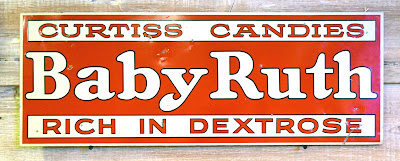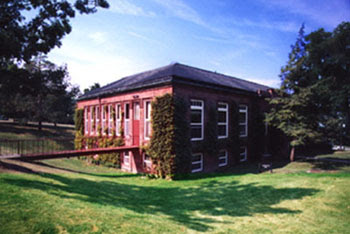Few would have imagined when Stephen Grover Cleveland was born in New Jersey, in 1837, he would go on to make history in a number of ways: he would become President of the United States; he would be the only President to serve two non-consecutive terms in office; he would be the only President to ever be married in the White House; and he would play a crucial role in the development of one of the most famous candy bars of the 20th century.
In 1850, Cleveland's father, a Presbyterian minister, moved the family to New York. When his father died in 1853, Stephen Grover Cleveland moved to Buffalo, New York. Here he began dropping his given first name and referred to himself as simply Grover Cleveland. He became a clerk in a law office and passed the bar exam and began practicing law in 1859. In 1862 he left the law firm in which he had studied and worked to start his own firm. His partner in the law firm was Oscar Folsom, who soon became his best friend.
 |
| Grover Cleveland as a young lawyer, before his girth so greatly increased. He eventually weighed 350-360 pounds. |
A confirmed bachelor, Grover Cleveland grew very close to Folsom and his wife Emma. When a daughter was born to the family of his partner in 1864 he took an avuncular interest in her well-being, buying her a baby carriage, toys, clothing and other presents. Cleveland was 27 years old when the Folsom daughter was born. Her name was "Frances" (Cleveland nicknamed her "Frankie.") and she would play a central role in his life. When she was a young girl he bought her a puppy and would bounce her on his knee at picnics and family visits and doted on her as if she were his own daughter. In 1875 everything changed. His law partner Oscar Folsom was killed in a gruesome and violent carriage accident. Oscar was returning home from visiting a friend and his buggy collided with a wagon. Folsom was thrown from his buggy and, falling underneath the wheels of his vehicle, he suffered extensive internal injuries and a fractured skull. He died in less than two hours, at the age of 37, leaving behind both his widow and daughter.
Cleveland became the executor of the Folsom estate and came to feel a special responsibility to Emma Folsom and her 11 year old daughter Frances. Young Frances often referred to her caretaker and uncle figure as "Big Steve" (a reference to Cleveland's now unused first name), "Uncle Cleve" or "Uncle Jumbo." Why these nicknames? As Grover Cleveland approached the age of forty his weight increased to 250 pounds (by the time he became President his weight had increased to 350-360 pounds).He did not exercise. He hated to walk, an activity he considered boring and extremely unpleasant. He loved drinking beer and eating bratwurst. He did much of this as he climbed the political ladder in New York State. He became the Sheriff of Erie County, New York, the Mayor of Buffalo, New York, Governor of the state of New York, and finally President of the United States, elected to his first term in November, 1884.
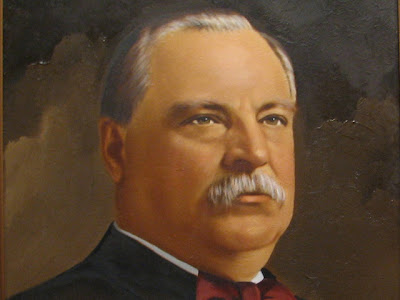 |
| President Grover Cleveland, alias "Big Steve,""Uncle Cleve" or "Uncle Jumbo." |
As Cleveland was climbing up the political ladder "Frankie" was attending high school and went on to graduate from Wells College in Aurora, New York, in the spring of 1885. (A college educated woman was a rarity at this time, but THAT is another story.) Sometime during her years at college Cleveland's feelings toward Frances had transformed themselves into something more romantic. Cleveland asked permission from Frances' mother Emma to correspond with Frances. She gave her permission. He corresponded with her regularly and sent her flowers quite often.
 |
| Frances Folsom just before her wedding to President Cleveland in 1886. |
Cleveland's affectionate feelings were reciprocated. It seems that as Frances matured the feelings they had for one another had blossomed into romance. Cleveland proposed marriage to Frances in a letter sometime in August, 1885. She accepted his proposal by return post. Throughout the rest of 1885 and in 1886 Frances Cleveland and her mother Emma visited Cleveland in the White House numerous times. Cleveland and Frances secretly became engaged to be married, the engagement not being announced to the public until five days before the wedding in the Blue Room of the White House on the evening of June 2nd, 1886. It was a small, intimate gathering with only 28 guests.
 |
No photographs were allowed at the small White House wedding on June 2nd of 1886. |
Frances Folsom Cleveland became the youngest first lady in history, 21 years old. Frances and Grover Cleveland had the only Presidential wedding ever held in the White House. She was 21, he was 48. This age difference, though extreme, was not that unusual for the time. This marriage itself was unusual because Cleveland had been the executor of Oscar Folsom's (France's father's) estate and had supervised Frances' upbringing (being her virtual guardian) after her father's death, but the public did not object to the difference in their ages or the circumstances of their long relationship. Women, not having access to career opportunities or allowed to live independently of either family or a husband, often married for security, and older men were usually better off financially and had careers that allowed them to better support a family. But by all accounts this was a love match. France's petite appearance and charming ways were in contrast to Cleveland's weighty appearance and gruff manner.
QUESTION/DIGRESSION:
Question: did Frances Folsom's college education make her "unsuitable" as a partner for marriage in the eyes of many men (and women) of the 1880s? After all, women were told that if they got too much education they would become sterile and not be able to have children. This was communicated through organized religion, doctors and society in general. Also, women were thought to be unequal to the task of academic learning. They would mentally break down under the strain. They were told their brains were smaller and couldn't absorb the amount of knowledge that men could. Another question: Did she have any other suitors? Just who did a college educated woman marry? The President of the United States? Studies have indicated that, on average, men marry "down", not wanting a woman who is smarter or more successful professionally than he is. Women, on the other hand, marry "up", seeking out someone who is as intelligent or even more so and who is as successful , or more successful, than she is. Just wondering. What do you think? ANOTHER DIGRESSION: ANOTHER FAMOUS "GROVER."
One of the most popular characters on the PBS TV show "Sesame Street" is "Grover."
Grover is actually (and I'm not making this up!) named after President Grover Cleveland.
 |
| "Grover" in his alias of "Super Grover" with his sidekick Elmo, another Sesame Street favorite. |
Here is a clip from Sesame Street in which Grover appears as
a contestant on the game show "Beat the Time" starring the world's most popular game show host Guy Smiley. Enjoy.
a contestant on the game show "Beat the Time" starring the world's most popular game show host Guy Smiley. Enjoy.
Where does the name "Grover" come from?
The name "Grover" comes to us from the Old English word "grover" that meant "grove of trees."
END OF DIGRESSION
 |
| Frances Cleveland with her first child, Ruth, who was dubbed "Baby Ruth" by the press. |
"Baby Ruth" became as admired and beloved as her mother to the American public. Some statistics offer a measure of Ruth's popularity with the citizens of the U.S. In 1890, one year before her birth, the name "Ruth" ranked #46 in popularity amongst all the names given to baby girls. By 1893 "Ruth" had jumped up to become the 5th most popular girl's name in the U.S. In the decade 1900-1910 "Ruth" ranked as the 4th most popular girls name in the entire country. All due to the popularity of "Baby Ruth" and the admiration of the nation for her mother Frances Cleveland.
NOTE:
The name "Ruth," a Biblical name, is believed to be of ancient Hebrew origin and a contraction of the Hebrew word "re'uth" which means companion or friend. "Re'uth" then becomes "Ruth." In English, the name Ruth has, over its history, come to mean the qualities of compassion, mercy and sympathy.
 |
| Artist's depiction of the Biblical "Ruth." |
BACK TO THE STORY.
The Presidential election of 1892 was a rematch between the incumbent Republican Benjamin Harrison and Democrat Grover Cleveland. This time, Cleveland won and he and Frances moved back into the White House in March of 1893. Cleveland's inaugural parade was a spectacular affair. More than 25,000 people marched in the parade, including thousands of Civil War Veterans. The parade included "Buffalo Bill" Cody and his Wild West Show (the most popular show in the U.S. at the time and for many years to come), trained seals, acrobats, clowns, dog acts and even dancing horses. One marcher stopped in front of the reviewing stand and released a brown rooster which was meant as a gift for the now 17 month old "Baby Ruth" Cleveland.
NOTE:
 |
| Grover and Frances Cleveland with their first child Ruth Cleveland. |
 |
| Ruth Cleveland was so adored that she inspired a number of popular songs. Here is an example of one simply titled "Baby Ruth." |
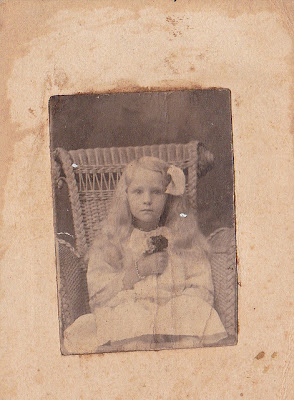 |
| "Baby Ruth" Cleveland as a young girl. |
12 YEARS LATER. THE STORY CONTINUES.
CANDY HISTORY IS MADE!
The "Baby Ruth" candy bar was first produced in 1920 by the small-scale Curtiss Candy Company of Chicago, Illinois. The company, which started in 1916 and was owned by a man named Otto Schnering, began with only a five gallon kettle and a stove in a leased room over a plumber's shop. Mr Schnering, who wanted a name more "American-sounding" than his own for the company -- German surnames not being much of an asset during World War I -- used his mother's maiden name instead. Thus, the Curtiss Candy Company was born. Their first product, "Baby Ruth Bar," was actually a re-naming of a candy bar the company had previously made and sold under the name "Kandy Kake," which had a a pastry center topped with nuts and coated with chocolate.
 |
| 1920 print ad for the Curtiss Candy Company's "Kandy Kake" candy bar. |
The re-named, re-shaped and re-formulated recipe that now consisted of peanuts, caramel and chocolate, in a unique log-shape, greatly appealed to the country's, and the world's, growing sweet-tooth. Schnering priced the candy at five cents a bar (half the cost of other bars), and soon had one of the hottest-selling candy bars on the market. According to one source, by 1926 the Baby Ruth Bar was selling at the rate of five million bars a day!
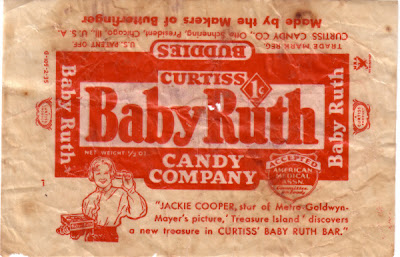 |
| An early "Baby Ruth" candy wrapper (1934). |
Otto Schnering was probably the first candy maker to fully capitalize on the power of advertising to promote his product. In 1923 he chartered an airplane and dropped Baby Ruth candy bars over the city of Pittsburgh, Pennsylvania, each bar attached to its own small parachute. It was an advertising success story that he repeated in a number of other locations. Beginning in 1931 the Curtiss Candy Company marketed the Baby Ruth Bar by sponsoring the Baby Ruth Aerobatic Team, a group of stunt flyers and planes that entertained people throughout the nation and had the Baby Ruth name printed in huge letters across the side of the aircraft.
Two examples of the touring Baby Ruth Aerobatic Team.
The new name of his product, Otto Schnering said, was,..." in honor of the daughter of former President Grover Cleveland," who as a young child had won the hearts of the nation and whose growing up had fascinated the public. (It was not, he said, named after George Herman "Babe" Ruth, 1895-1948.) This has been the "official" version of the Curtiss Candy Company since the 1920s. Other sources state that George Herman "Babe" Ruth, a standout pitcher and hitter, was sold by the Boston Red Sox to the New York Yankees prior to the 1920 season, and that he soon established himself as a star hitter and outfielder and was nationally famous by the end of the 1920 baseball season.
 |
| Babe Ruth, already a star baseball player, was traded to the New York Yankees in 1920. |
By 1921 (the latest date given for the introduction of the "Baby Ruth" candy bar) his name was featured more prominently on the front pages of afternoon newspapers than President Harding's. So the question remains, who is the Baby Ruth Candy Bar really named after? The Curtiss Candy Company insisted that Babe Ruth did not become a household name, a "star," until well after 1921, but the facts seem to contradict this statement.
 President Warren Harding, 1921-1923. |
| By the fall of 1921 Babe Ruth was getting more coverage in the press than President Warren G. Harding. |
President Herbert Hoover, 1929-1933.
His salary was less than that of Babe Ruth
and the country was sliding into an
economic depression. In 1930 Ruth
signed a contract with the Yankees that
economic depression. In 1930 Ruth
signed a contract with the Yankees that
paid him $80,000 a year, more than the
$70,000 President Hoover was making.
When asked about it, "The Babe" said,
"What's Hoover got to do with it? I had
a better year than he did."
$70,000 President Hoover was making.
When asked about it, "The Babe" said,
"What's Hoover got to do with it? I had
a better year than he did."
So the debate over the origin of the candy bar's name continued, and continues, to this very day. Was it truly a tribute to a 12 year old girl who had died 16 years previously or only a way to avoid paying Babe Ruth for use of his name? Naming a candy bar after the long-dead daughter of a former president would certainly be a curious choice. Would children, the main consumers of the candy bar, even know who "Baby Ruth" was? They would be more likely to know who Babe Ruth was! Moreover, the notion that a candy bar called "Baby Ruth" should appear on the market just when a baseball player named Babe Ruth had suddenly become the most famous person in America was perceived as a rather striking coincidence. In fact, the Curtiss Candy Company took Babe Ruth and a competing candy company to court in 1930 to keep them from selling a candy bar that used Babe Ruth's own name: "The Babe Ruth Home Run Bar." They won the suit, and the Babe Ruth Home Run Bar was withdrawn from the market.
 |
| The Curtiss Candy Company forced the withdrawl of this candy bar from the market in 1930 because it infringed on the "Baby Ruth" trademark name. |
SO THERE ARE TWO STORIES. TAKE YOUR PICK.
In 1932 the Curtiss Candy Company introduced the "Butterfinger" candy bar and it proved to be a huge success. The Curtiss Candy Company advertised the Baby Ruth and Butterfinger candy bars extensively in print ads from the 1920s through the 1960s in magazines and newspapers.
This 1934 print ad portrayed the Baby
Ruth Candy Baras fuel for the body. Just
like a car needs gas your body needs
dextrose, an energy source provided
by Baby Ruth Candy Bars. Again,
marketing candy as a food rather than
a treat or pleasure. Notice there
are only adults in this ad. No children.
Ruth Candy Baras fuel for the body. Just
like a car needs gas your body needs
dextrose, an energy source provided
by Baby Ruth Candy Bars. Again,
marketing candy as a food rather than
a treat or pleasure. Notice there
are only adults in this ad. No children.
The Baby Ruth Candy Bar became so famous that new and imaginative ways were developed to use them. One idea was to utilize them to make cookies by either slicing them up and serving them as is or mixing them in a cookie batter.
During the 1940s and WW II the marketing of the Baby Ruth Candy Bar took a turn toward making boys into men, and encouraging families on the home front to send boxes of Baby Ruths to their sons in the military. (Hershey Bars were already in the ration packs distributed to all soldiers in the theaters of war) Here are a couple of examples:
This print ad from 1943, in the middle of WW II,
suggested that the nutrition of a Baby Ruth
Candy Bar would help develop boys into men
(future soldiers?) and that purchasing
Baby Ruths was also "patriotic."
(future soldiers?) and that purchasing
Baby Ruths was also "patriotic."
Then, in the 1950s, the emphasis in Baby Ruth print advertising was slanted toward young boys and sports. No girls in this ad.
This early 1950s ad claims to give boys the
energy to run around the bases 27 times
on the energy (again, from dextrose) found
in one Baby Ruth Bar.
energy to run around the bases 27 times
on the energy (again, from dextrose) found
in one Baby Ruth Bar.
Below is a Halloween print ad from 1956 in which the Curtiss Candy Company encourages parents to give out both Butterfinger and Baby Ruth candy bars to trick-or-treaters. (The smaller "fun-size" version of these bars had not yet been thought of or marketed.) The "Goblins" actually received a whole candy bar!!
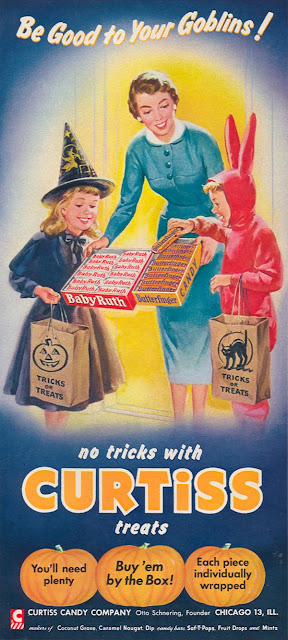 |
| 1956 print ad that appeared in magazines and newspapers. By this time both Baby Ruth and Butterfinger candy bars had become candy favorites on the American scene. |
In the 1960s Baby Ruth print advertising encouraged people to give BOXES of Baby Ruth candy bars as Christmas presents. This ad is from 1965.
Or, if you preferred the
Butterfinger Candy Bar, you
could buy boxes of them for those
Butterfinger Candy Bar, you
could buy boxes of them for those
you loved and cared for!!
Baby Ruth (and Butterfinger) continued to be two of the most popular candy bars in the U.S. They have advertised extensively on TV and more recently have tried to portray the Baby Ruth candy bar as a more modern and up-to-date product (as opposed to the old advertising images I have offered earlier in this post). Here are a few TV commercials that make this point.
1980s Baby Ruth/Butterfinger TV ad.
Here is a link to a 1990s "FUNKY"/HIP HOP
Baby Ruth commercial that illustrates the
distance the product and its image has come
during the course of its history:
The classic but crude film comedy "Caddyshack" starring Bill Murray, Chevy Chase and Rodney Dangerfield used a Baby Ruth candy bar as a prop for what some have said is one of the most hilarious and gross scenes in the film. Here it is:
I don't think Baby Ruth appreciated this use of its name and product.
Talk about "product placement"!
Fun facts about Grover Cleveland, Ruth Cleveland, and Candy!
*** Americans eat, on average, more than 25 lbs. of candy a year (not including chewing gum), and at least half of it is chocolate.
*** Candy bars became an American institution and cultural phenomenon during WW I when they were mass-produced and sent to Europe, according to the National Geographic
Society, for "...the morale, health, and even survival of the doughboys" (American soldiers).
*** In the past the Curtiss Candy Company made the claim that Ruth Cleveland "visited the Curtiss Candy Company plant in 1916 when the company was getting started and that this visit largely influenced the company's founder (Otto Schnering) to name the candy bar 'Baby Ruth'". Ruth Cleveland died at age twelve in 1904. By no stretch of the imagination can this story be believed. Ruth Cleveland died in 1904. How could she have visited the factory at its start in 1916?
*** Cleveland's portrait was on the U.S. $1000 bill of series 1928 and series 1934.
*** In honor of Frances Cleveland, a graduate of Wells College, "Cleveland Hall" was constructed in 1911 on the Wells College Campus. Originally a library, the building currently specializes in foreign language classes.
Cleveland Hall, Wells College, present day.
*** President Grover Cleveland, Frances Folsom Cleveland and"Baby Ruth" Cleveland are all buried together in Princeton, New Jersey.
FINIS.



